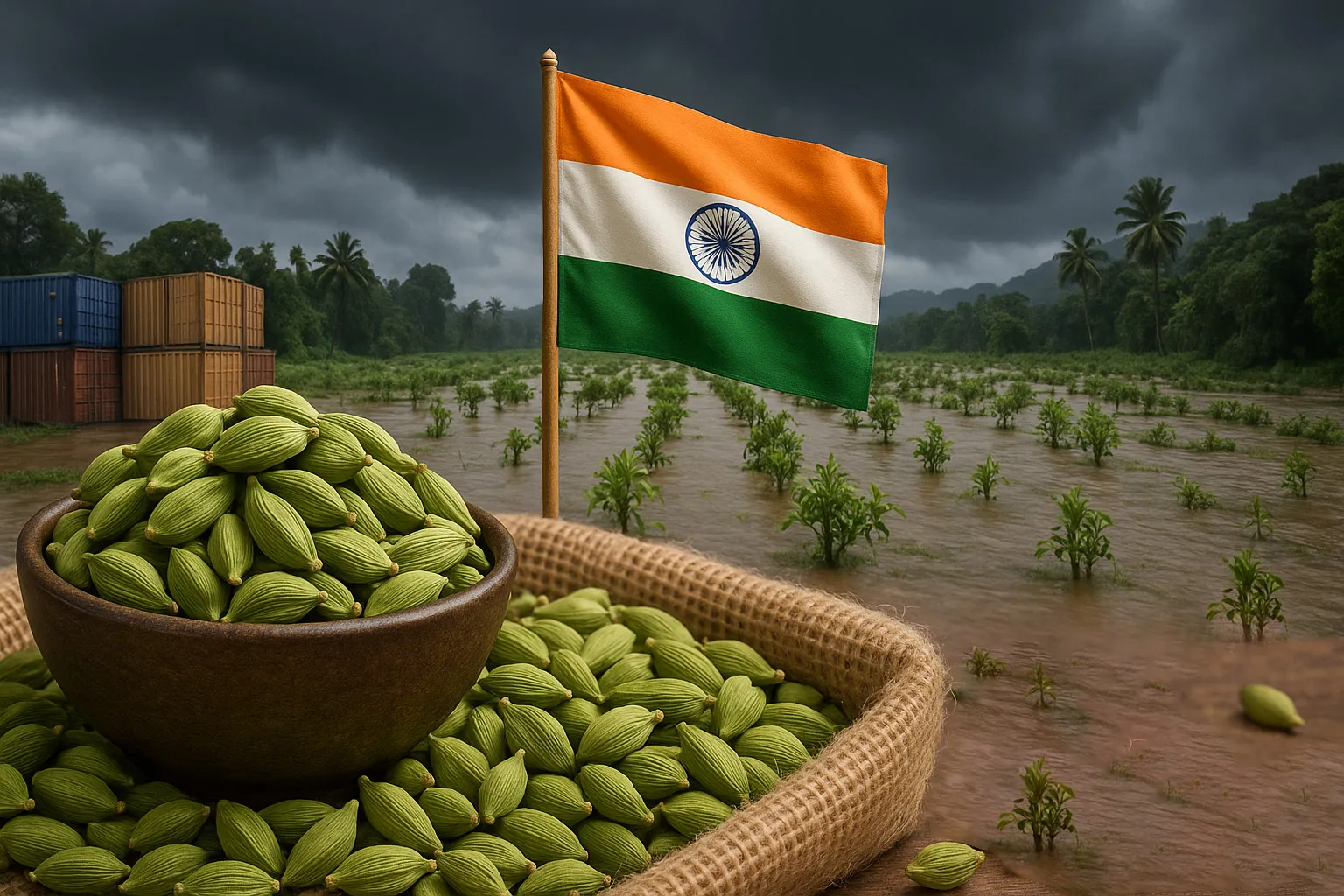How Severe Weather in India is Shaping the Future of Global Cardamom Trade: What's Driving the Market?
The global cardamom market is experiencing significant turbulence driven by severe weather disruptions, fluctuating prices, and shifting export dynamics. India's prominent role as a major producer and exporter underscores the global implications of recent developments.

Latest Market Updates & News
Severe Weather Disruptions
- Catastrophic flooding in Northeast India (Assam and Meghalaya) has significantly reduced market arrivals by approximately 60–70%.
- Neighboring countries Bhutan, Sikkim, and Nepal also report substantial crop losses.
- Despite these supply constraints, wholesale prices for big cardamom (Kainchi Cut variety) remain relatively stable, around USD 19.42–19.53 per kg as of April 22, 2025.
Export Resilience
- India's cardamom exports reached 915.41 tonnes, valued at USD 17.46 million, from April to November 2024.
- Strong international demand continues despite elevated prices, though future growth remains uncertain due to domestic supply constraints.

Global Production Status
India
- Crop losses in Assam and Meghalaya due to flooding (60–70% estimated reduction).
- Production had previously stabilized around 350,000 tonnes annually.
- Ongoing weather instability complicates production recovery efforts.
Nepal & Bhutan
- Nepalese market supply limited, daily arrivals reduced to 500–1,000 sacks.
- Bhutan experiences similar crop losses due to drought and heat waves.
- High export prices from Nepal restrict significant trade activities.
Exporters, Importers & Trade Flows
Key Export Destinations
- European markets (Italy, Germany, Belgium), Middle East, and Russia are the primary importers of Indian cardamom.
- Nepal’s elevated prices shift importers' focus primarily towards India.
- India's exports show resilience despite disruptions, indicating sustained international demand.

Product Quality, Harvest Timing & Characteristics
- Indian big cardamom prized for complex aroma and robust flavor.
- Adverse weather potentially affecting aroma intensity and bean size this season.
- Harvest peaks:
- India: November–March
- Bhutan and Nepal: Similar harvest timelines

Current Prices & Short-Term Outlook
- Indian whole cardamom (#113 variety): Approximately USD 26.93/kg (EUR 24.88/kg).
- Organic whole cardamom: Approximately USD 18.54/kg (EUR 17.13/kg).
- Short-term forecasts indicate prices between USD 17.00–19.50/kg due to ongoing market uncertainties and tight supplies.

Market Analysis & Fundamental Signals
- Reduced arrivals from flooding underpin current prices, preventing major declines.
- Stable export markets but potential tempered growth due to competitive pricing.
- Speculative buying may lead to temporary price spikes, benefiting strategic sellers.
Tariff & Policy Watch
- Currently, no major tariff changes affecting the cardamom market directly.
- International traders advised to monitor broader economic policies that might indirectly influence trade dynamics.
Strategic Insights for Momex Stakeholders
- Buyers:
- Secure short-to-medium term contracts to mitigate risks from potential price hikes.
- Diversify sourcing to buffer against supply disruptions.
- Sellers:
- Capitalize on current market conditions by emphasizing premium quality and consistency.
- Maintain transparent communication regarding product quality to build trust.
- Traders:
- Regularly monitor weather forecasts and export trends.
- Adjust trading strategies swiftly to leverage market fluctuations.

Auction Dynamics
- Recent auctions (March 20) recorded prices between USD 16.80–21.60/kg based on quality.
- Indicates cautious buyer interest and moderate market optimism.
Global Competitiveness
- India remains dominant but faces increasing competition from Africa and South America due to Asian supply disruptions.
- Emerging markets actively exploring opportunities to fill supply gaps.
Consumption Trends
- Rising global use in culinary and medicinal applications boosting overall demand.
- Increased preference for premium and organic cardamom products driving market growth.
Additional & Complementary Updates
- African and South American growers actively pursuing market opportunities amidst Asian supply disruptions.
- Increased global consumption in premium segments, especially organic cardamom, signaling a shift in buyer preferences.
Conclusion
The 2025 cardamom market faces significant volatility driven by climatic disruptions and supply constraints, notably affecting India and surrounding regions. While prices show moderate increases, continued tight supplies and stable demand suggest further market fluctuations. Strategic procurement, robust quality assurance, and proactive engagement are essential for stakeholders to effectively navigate these challenges.
FAQs
What is the current price of cardamom in 2025?
As of April 2025, the price for Indian whole cardamom (#113 variety) is approximately USD 26.93/kg, with organic variants around USD 18.54/kg.
Why have cardamom prices increased?
Prices have risen primarily due to severe flooding in Northeast India and neighboring regions, significantly reducing crop yields and market supply.
Which countries are major importers of Indian cardamom?
Major importers include European countries (Italy, Germany, Belgium), Middle Eastern nations, and Russia.
How is severe weather affecting cardamom production?
Flooding in India and drought conditions in Bhutan and Nepal have caused substantial crop losses, impacting overall supply and quality.
What is the short-term price forecast for cardamom?
Short-term forecasts indicate prices will remain volatile, generally ranging between USD 17.00–19.50/kg, influenced by ongoing supply disruptions and market uncertainties.









